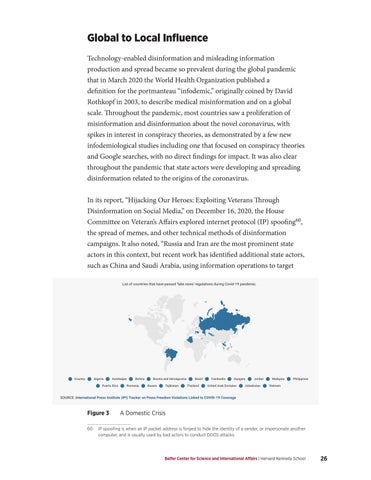Global to Local Influence Technology-enabled disinformation and misleading information production and spread became so prevalent during the global pandemic that in March 2020 the World Health Organization published a definition for the portmanteau “infodemic,” originally coined by David Rothkopf in 2003, to describe medical misinformation and on a global scale. Throughout the pandemic, most countries saw a proliferation of misinformation and disinformation about the novel coronavirus, with spikes in interest in conspiracy theories, as demonstrated by a few new infodemiological studies including one that focused on conspiracy theories and Google searches, with no direct findings for impact. It was also clear throughout the pandemic that state actors were developing and spreading disinformation related to the origins of the coronavirus. In its report, “Hijacking Our Heroes: Exploiting Veterans Through Disinformation on Social Media,” on December 16, 2020, the House Committee on Veteran’s Affairs explored internet protocol (IP) spoofing60, the spread of memes, and other technical methods of disinformation campaigns. It also noted, “Russia and Iran are the most prominent state actors in this context, but recent work has identified additional state actors, such as China and Saudi Arabia, using information operations to target
Figure 3 60
A Domestic Crisis
IP spoofing is when an IP packet address is forged to hide the identity of a sender, or impersonate another computer, and is usually used by bad actors to conduct DDOS attacks.
Belfer Center for Science and International Affairs | Harvard Kennedy School
26





